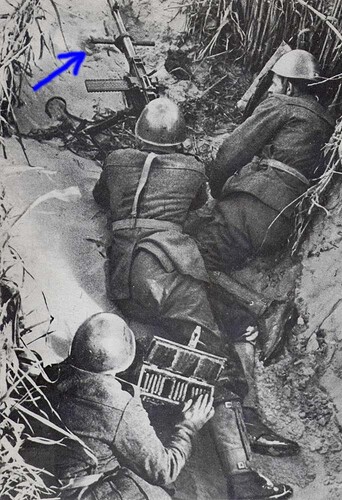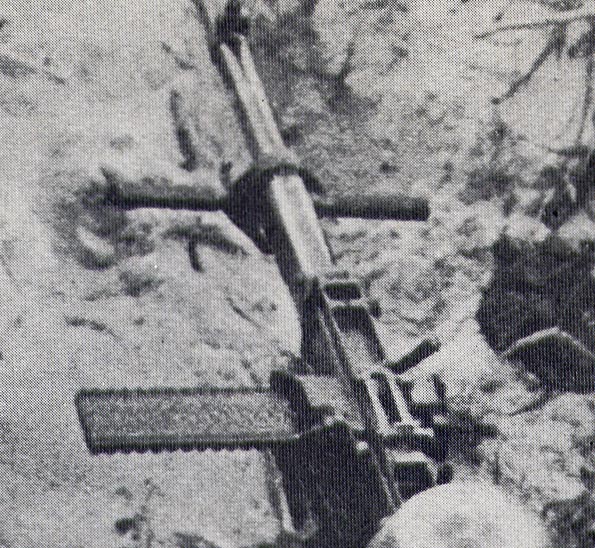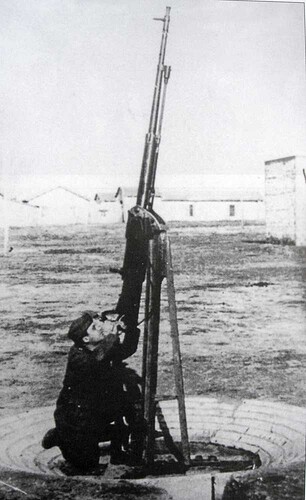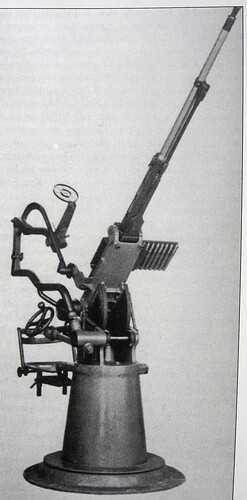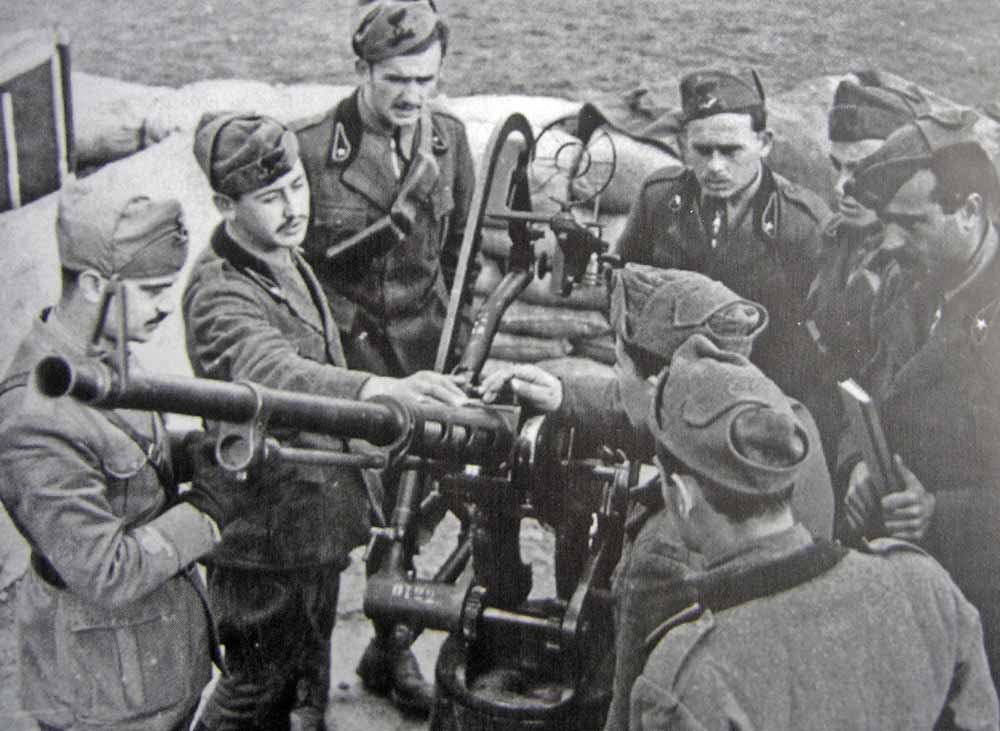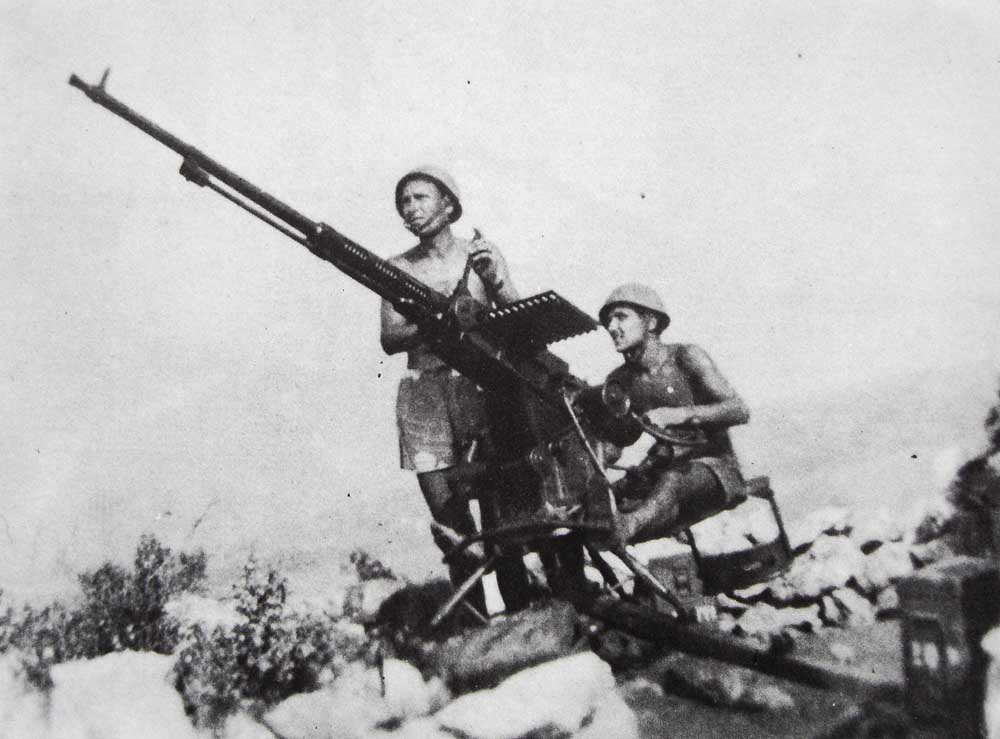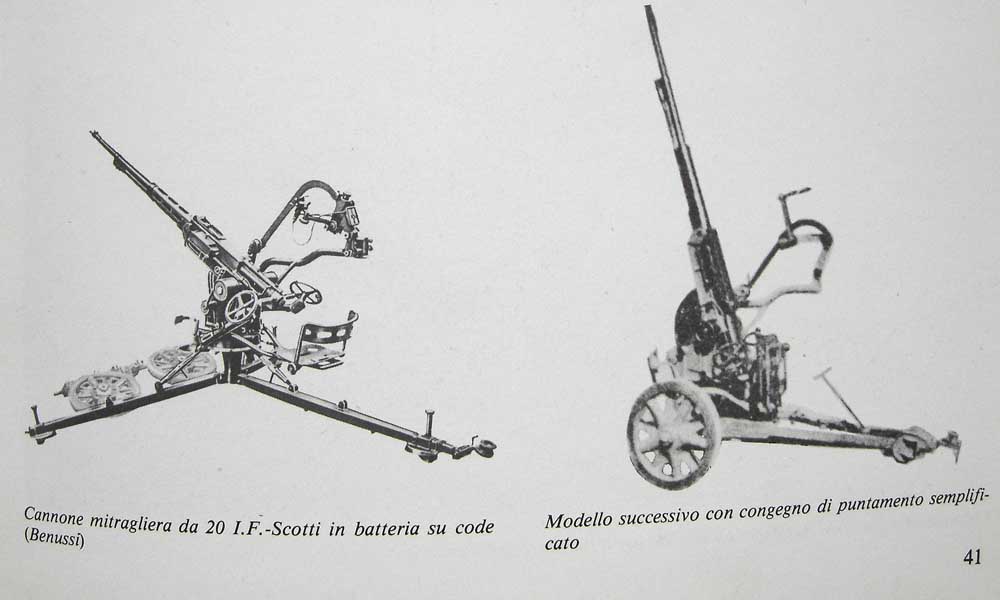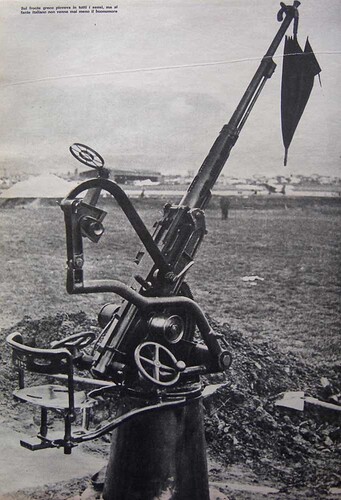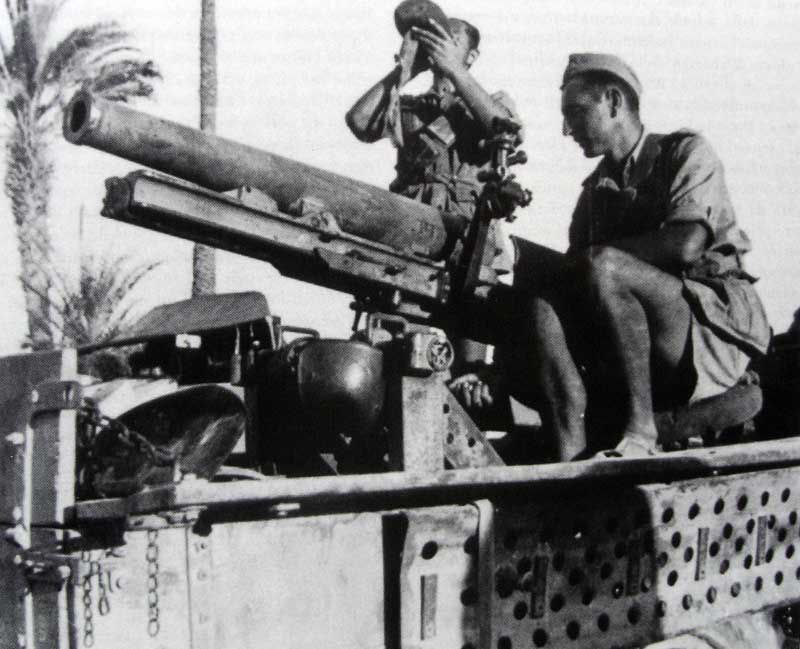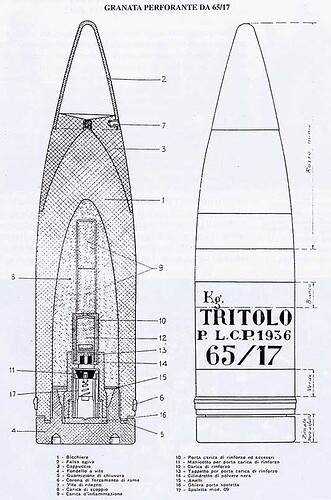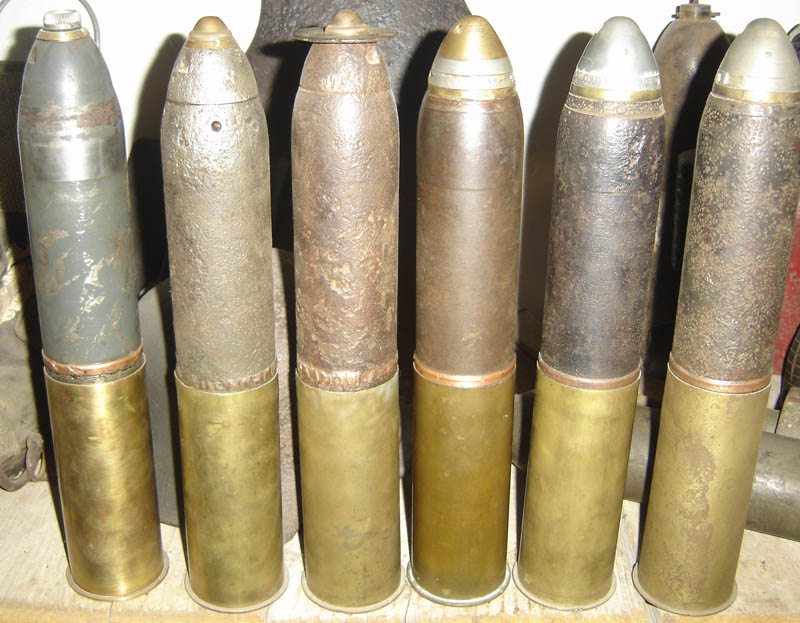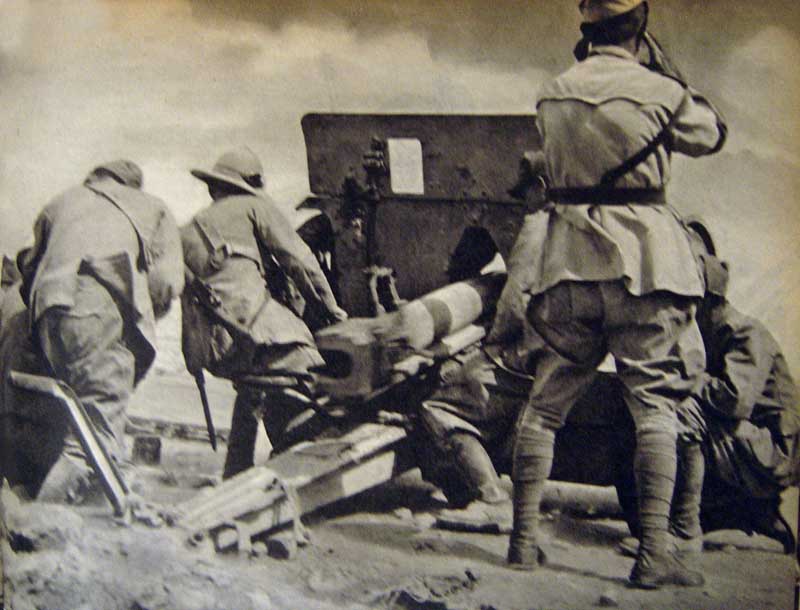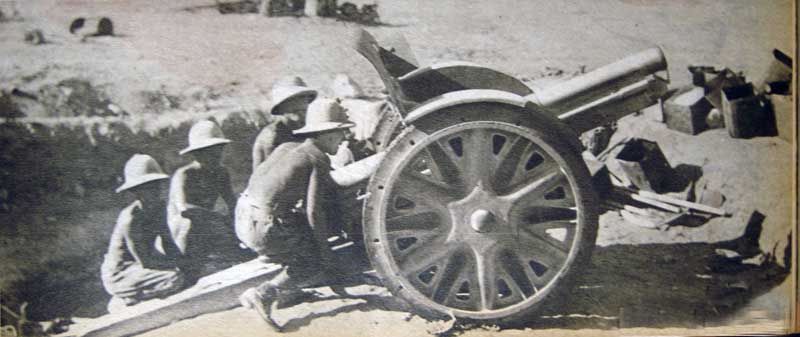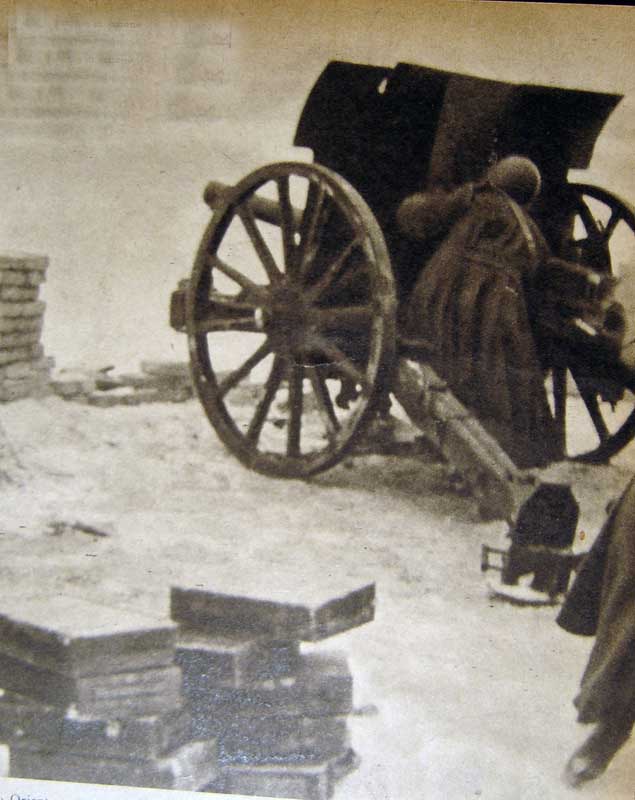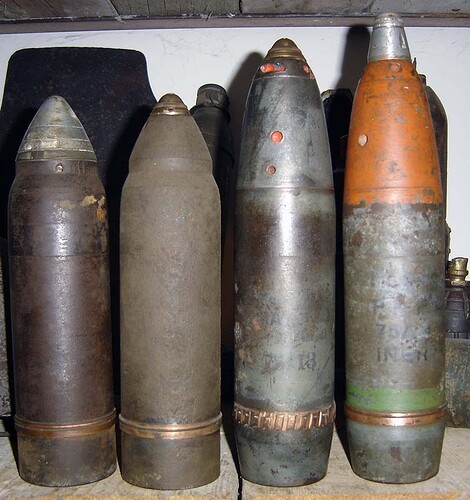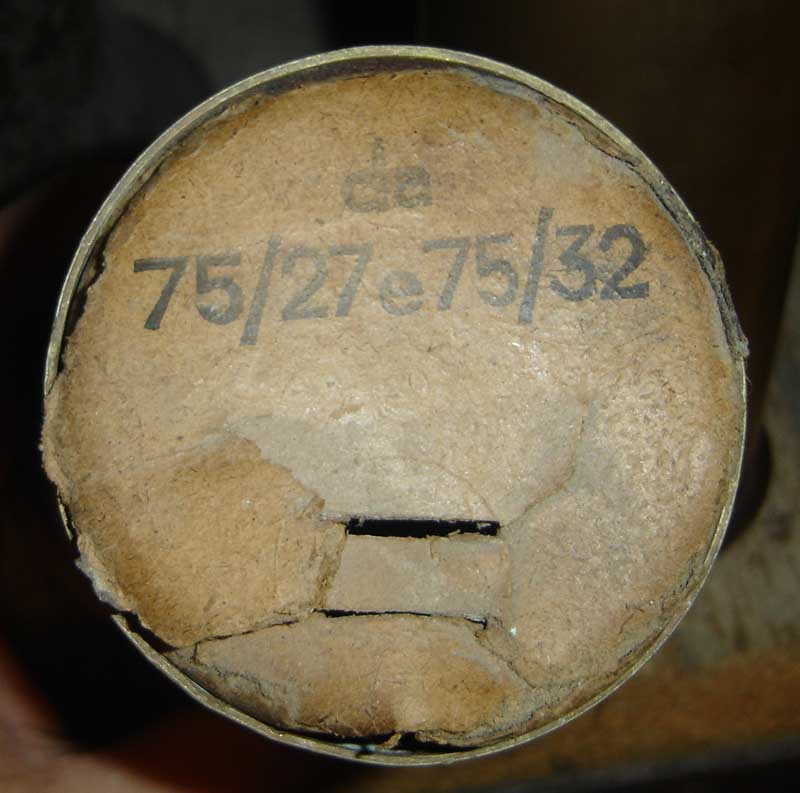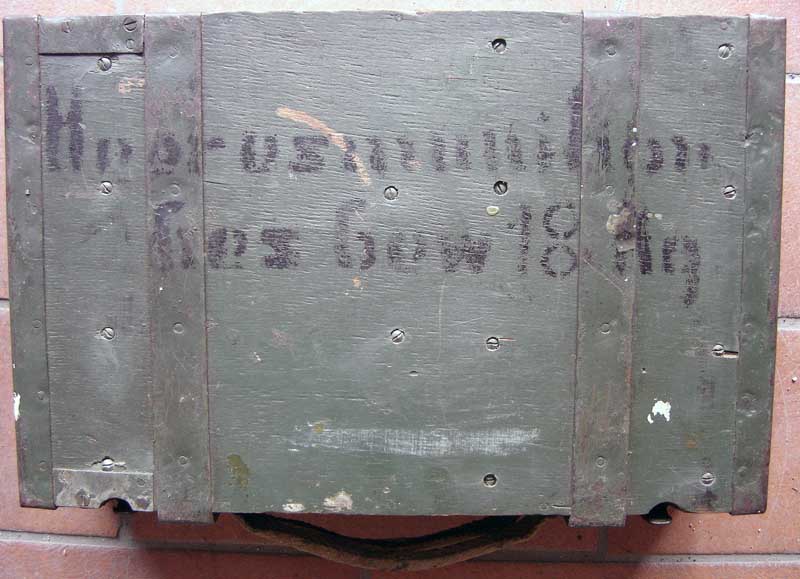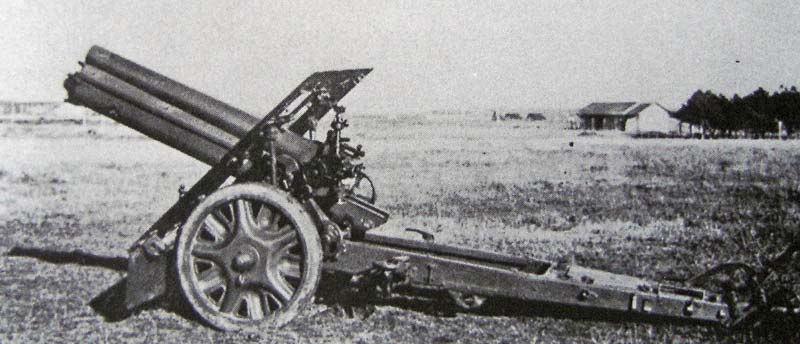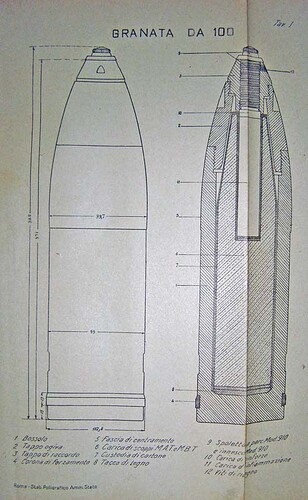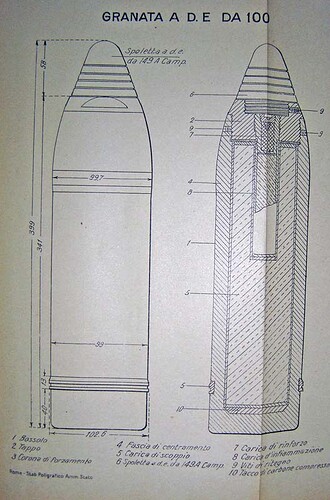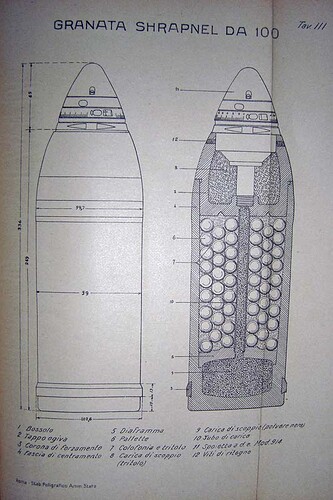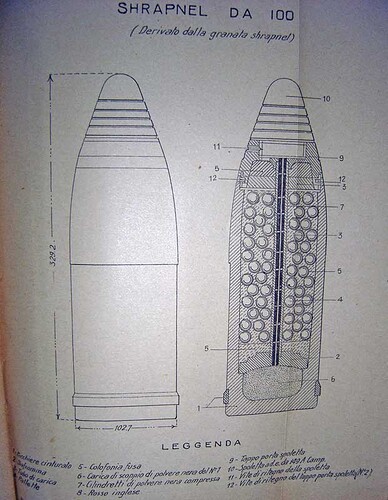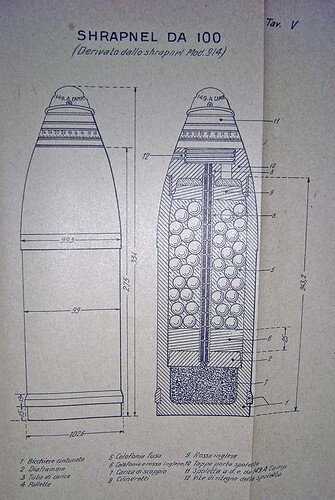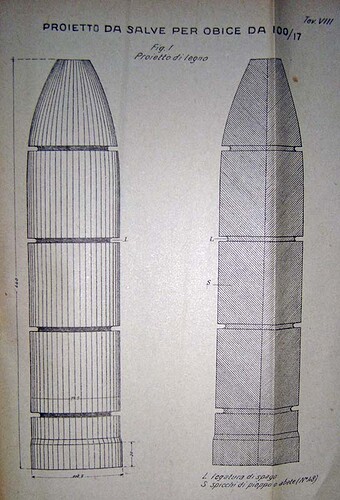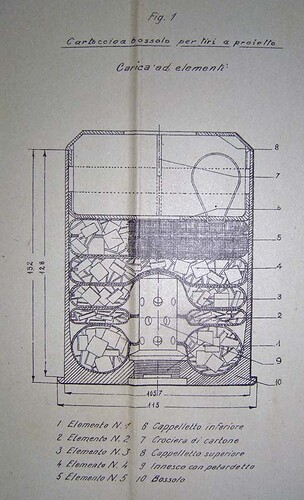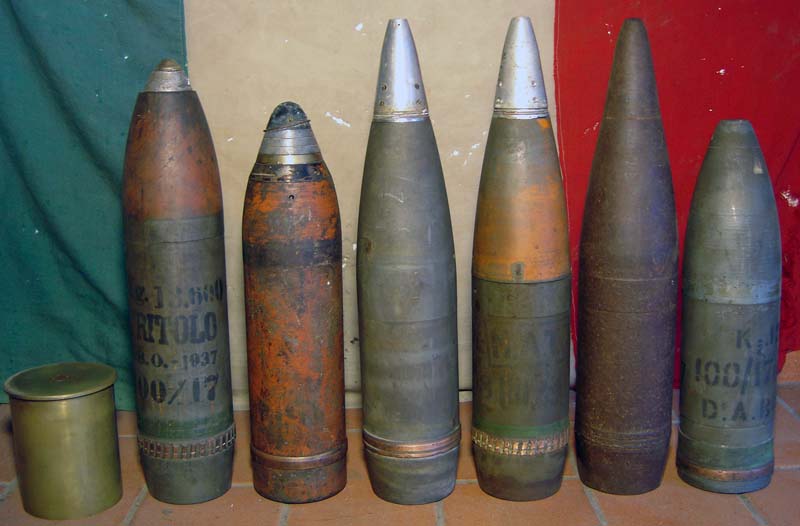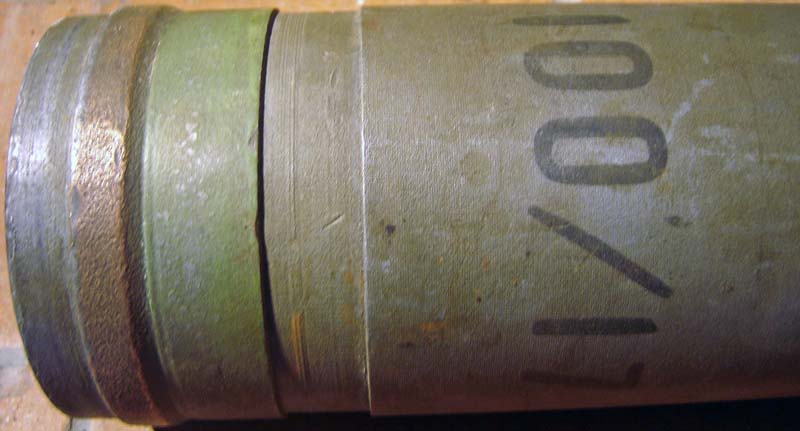Problem solved then, Danke tony, the Scotti was also in 20x138b caliber and a better design than the Breda 20/65.
thanks,
Im happy to share these with you.
It’s a gear to rapid change the barrel. the breda 37 8mm MG used a similar gear.
cannone mitragliera da 20/70 scotti-isotta-fraschini-om:
The firm Alfredo Scotti in Brescia, at the end of 20’s, patented an original mechanism of closing for automatic weapons with tangential arrest of the bolt with rotating head. This solution foun application in many weapons, from rifle caliber to 40mm. In the 30’s the firm Isotta Fraschini in Milano bought the right to build all the Scotti’s weapons, so were developed and improved. Scotti-IF developed also MG belt and magazine fed in caliber 6.5mm, 7.7mm, 8mm, and 12.7mm, always defeated by the Breda’s weapons.
Te first model of 20/70 IF (1934) was chambered for the 20x110RB, oerlikon, with 60 round drum magazine. After the adoptption by navy and army of Breda 20/65 in 20x138B, the IF was constricted to change hte ammunition, and adoptede the 12 round strip magazine used in the Breda.
In 1938 army and navy oredered some IF gun, 50 with wheel gun carriage, and 150 with navy gun carriage. In 1939 the scotti Isotta Fraschini was again improved, by the feeding mechanism and gas pressure valve. The definitive model appear in 1941, and was reproduced by Società Anonima OM(Officine Meccaniche) in Brescia, and by C.E.M.S.A.(Caproni Elettro Meccanica Società Anonima) in Saronno. Many kind of gun carriage were developed, I only enclose some picture. Navy used Breda gun carriage wit S-IF gun, twin gun was also built.
In 1943 DICAT (DIfesa Contro Aerei Territoriale = anti aircraft territorial defence) has 545 S-IF mod 39 and 41. Was developed a quadruple gun like german flakvierling, also mounted on M15/42 tank.
After 8 september 1943, german produced S-IF like 2cm FlaK Scotti(i) in north italy firms. In february 1945 Luftwaffe has 497 IF
some pictures:
1 free pointment carriage
2 navy
3 mod 41
4 free pointment
5 schematic field carriage
6 field carriage action
7 field carriage with different sight, 2nd was simplified
8 navy mounts in ground use, with italian humorism, antiaircraft umbrella…
Very good photos, too bad the 12 rounds magazine, sound little for continuous firing.
I had forgotten that the Solothurn had a changeable barrel, (a senior moment I think,) makes sense, no fun handling a hot tube when changing.
65/17 mod 1911
Developed as mountain gun, the piece responded well a great deal to the 1ww operational employment resulting precise, strong and reliable. Its greatest defect was the elevation, up to 20°, absolutely insufficient in the mountain ground. In fact the artillerymen were often forced to increase elevation lifting the gun on parapets of earth making, that did assume to acrobatic position
Besides, the lone charge, and the flat trajectory, they especially limited greatly the choice of the positions and the effectiveness in mountain ground.
In 1920 the gun was replaced by the Austrian howitzer 75/13 mod 15, clearly superior to the Italian piece. In 1926 it was attributed to the infantry. How weapon of infantry, a long range not being more necessary, and were distributed new ammunition with reduced charge, which allowed a rather curved trajectory, very more proper for the fire above the troops friends. In 1936 in the operations was thickly employed for the conquest of the Abbissinia, then in Spain.
In 1940 they were present 719 pieces with 1.542.000 shells. Particularly serious it was the lack of antitank ammunition , in the 1st year of war they were available only 93.600 APHE…. During the war it operate on all the fronts resulting extremely versatile and superior to the 47/32 by the most greater power and effectiveness of the APHE ammunition and EP (Effetto Pronto = ready effect = HESH). The EP ammunition were available from the spring 1942, and shipped to the 8 army and those fighting in Libya, in oriental and northern Africa. Was employed on Fiat 634 truck, 28 guns were installed on English Morris CS6 going to constitute together with 75/27 and 100/17 gun, the famous flying batteries. In January 1942 they were available 655 pieces, in December 444. in Tunisia they operated 96 pieces. The pieces captured by the Germans were renamed 6.5cm GebK 246(i ).
The ammunition were:
Torpedo shell with reduced and normal charge for the use of the infantry.
APHE with base fuze mod 09
Antitank shell EP, EPS with I-35 fuze (HEAT) and EPS 42 (HEAT) with special fuze of German conception.
Canister
Incendiary smoke shell with white phosphorus and I-38 fuze
Steel case was made too.
pictures:
tunisia, la spezia division
tunisia la spezia division with 3 wheel morcycle Trialce
russia
flyng batteries on british truck (morris ??)
drinking on flybg batteries
65/17 APHE with base fuze mod 09
some ammunition of ww1 design: 1, 2 3 torpedo shell, 3rd has the rosetta ritardatrice ( retarding plate) to curved the trajectory. the other are shrapnell
EP, EPS, canister and WP are missing, sorry.
Wonderful post fert, thanks:)
it’s a pleasure.
thanks to you.
greetings
Bump.
75/27 mod 06
The gun was the Krupp model for export adopted in Italy in 1906. Other nations adopted it were: Belgium, Holland Turkey Sweden Denmark Romania Switzerland.
After ww1 the gun was relegated to assignments of second line, coastal defence, strengthened works armament, position batteries GAF (Guardia Alla Frontiera = frontier guard) and groups of artillery displaced in colonies. Some were surrendered to Albania and Poland that used them against the Russian in the 1920 war. At ww2 eve they were in service 1700 guns mod 06.
In March 1940 the 75/27 mod 06 and 11 Deport were so distributed:
Infantry divisions: 2 groups 24 pieces
truck-borne divisions: 24 pieces
motorized divisions 16 pieces
armoured divisions 24 pieces
camice nere divisions 2 groups 24 pieces
75/27 mod 06 and 11 Deport were the pieces employed in greater number by the Italian army. The new artilleries model 35 and model 37, that would have replaced the old pieces Krupp and Deport, in June 1940 they had not entered production of series yet.
Because of the reduced caliber the 75/18 mod 35 and 75/32 mods37 already resulted obsolete before entering service.
The shell from 75mm resulted ineffective against the strengthened works, they didn’t destroy the trenches. By this way in Africa the 75/27 were clearly outclassed by the British 25pdr. To few it served the expedient to sink the tail of the gun mod 06 in a pit dug in the sand to increase the draught in elevation and to come to a maximum range of 10.2km.
Both in Northern Africa and in Russia, the redoubt effectiveness of the infantry antitank weapons, often forced the groups from 75mm and 100mm to take sides inside the advanced point, to help the action of fire.
Despite the vast employment in antitank role 75/27 were poorly fit to the contrast tank. gives the insufficient flat trajectory, the excessive height of the piece, the small horizontal sector of fire (especially Krupp), that prevented the fire against moving target to the brief distances. Other lacks were given by the impossibility from the pointer to contemporarily operate the mechanisms of aiming and shot, as well as the thickness of the shield, easily pierced by the AP bullets of enemy machine guns.
To improve the effectiveness of the antitank fire APHE shells was introduced EP ( HESH) and EPS (HEAT). In the action against tanks the max range was 700m, but for multiple objectives was recommended to begin the fire to 300/400m.
The mod 06 gun were employed in all the fronts except in Russia and oriental Africa.
In March 41 80 guns displaced in Albania;
69 in northern Africa in endowment to Bologna, Ariete, Sabratha and Sahara libico divisions, Catalano and Santa Maria columns
Libya October 1941: 263 guns; February 1943 96 guns, distributed to Trieste, Giovani Fascisti, Pistoia, Spezia, Centauro, Raggruppamento Shaariano
The Germans delivered pieces of Belgian origin with 38.000 round which also shot Italian ammunition, Dutch pieces Siderius and Yugoslav and Greek guns mod 903 and 904. After september 8 1943 the Germans denominated the gun FK 237(i)
75/27 mod 11 Deport
Adopted in 1911 to eliminate some deficiencies that emerged during test with 75/27 mod 1906 and the delay of deliveries of the pieces mod 906.
Italy enter ww2 with still the horse-drawn artilleries. Of 1300 75/27 mod 11 gun, only 268 had been modified for the mechanical drawing. Someone were replaced with pneumatic tyres celerflex, but the absence of special elastic organs they made the substitution useless.
The relationship of the general D’Antonio in Libya:
75/27 mod 11 gun celerflex wheel;
the material, for how much endowed with celerflex wheels results too much delicate to follow the normal speed and the long marches of the mechanized columns. They easily torn the bolts of the shield, and sometimes the trails was broken from the gun carriage.
In 1942 to increase the redoubt off road mobility, the 12° auto-raggruppamento in northern Africa install on tractors of artillery TL 37, the 75/27 gun mod 11 eliminating the wheels and cutting the tails.
In Russia some guns climbed on the pneumatic wheels recovered by large cases abandoned by the enemy. In 1941 the CSIR (Corpo Spedizione Italiano in Russia=Italian Russian Corps) then ARMIR (ARMata Italiana in Russia)had 48 guns climbed to 72 in 1942.In March 1941 148 pieces were in Albania. In October 1941 39 pieces in Tripolitania and 99 in Cirenaica. In the December 1942 after the battle of El Alamein the guns were reduced to 42, in Tunisia in 1943 only 10 guns had remained.
After September 8 the gun was renamed by the Germans 7,5cm Fk 244(i)
2nd picture is the conversion made by 12° auto raggruppamento on tractor TL-37
ammunition
Case: 75x185 rim 90mm; case also used on 75/18 field gun mod 35
Old ww1 shell with m10 fuze
M32 shell with M10 or IO40 direct action fuze
Double effect shell mod 32 wit time and percussion fuze mod 36
French shells mod 1900/15 and 17
Shrapnel wit mod 06 fuze
EP, EPS, EPS 42 antitank shells
White Phosphorus shell
Gas shell
In April 1943 2.842 75/27 round was prepared with Greek APHE captured shellswith French base fuze mod 18.
In 1942 firing tests were effected with EP shells on T-34 tanks; it doesn’t produce sensitive effects against the T34.
pictures:
1-shell: shrapnell, old ww1 model fuze m10; m32 shell fuze m10; m32 shell fuze IO40
2-case: brass and steel
3-cover
4-5-6-7 ammo box (german stencilling)
8-9 round position
10- shell detonator-plug-fuze
italian projectile for separated load
APHE
SAPHE
EP
EPS
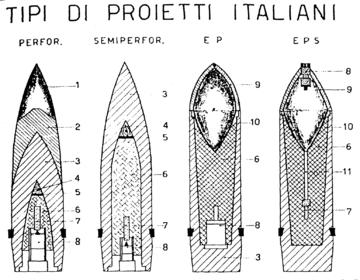
fert, or Tony W.
Do you have any detailed info on the 100/17 & it’s ammo, similar to that which you have posted about both the 65mm & 75mm pieces please?
Very good, is interesting to see the large and widespread use of the hollow charge ( effeto pronto = quick effect) projectiles. 
the lack of efficient antitank guns, made to develop HEAT ammunitions, to use on the existing guns, for the majority field guns, with low muzzle velocity.
the German supplies of antitank guns from 3.7cm pak, 5cm pak 7,5cm pak and 8,8cm flak never did not overwhelm the deficit.
@ DavidW: it’s in preparing.
picture: italian EP shell
greetings
Thank you kind sir.
100/17 mod 14 and 16
The victory on Austria Hungary of the ww1 delivered to Italian army 1339 100/17 mod 14 field and 95 mod 16 mountain howitzers. The captured material was also delivered in account damn-reparation of war, and quantified in 557 barrel + 56 gun carriage mod 16 mountain, 915 barrel + 735 gun carriage field. This resolved one of the greatest problems emerged during the ww1 the lack of a light curved draught howitzer.
The Skoda 10cm mod 14 and mod 16 were good weapons, solid and strong, besides the power of burst of the shells was clearly superior to that of the Italian 105/28 Ansaldo/Schneiders howitzers.
The lack of ammunition did that, a new model of shell was adopted, the mod 32 with 2,3 kg of tritolo (1 in more than the Austrians), good ballistic coefficient that increased the range about 500m. The residual Austrian
ammunition was standardized and endowed with Italian fuze. The howitzers were suited for the mechanical drawing, through elastic cart and semi pneumatic wheels.
Thanks the wide availability of howitzers, many were assigned to the GAF for the armament of strengthened works.
At the beginning of the ww2, the Army had available 1325 howitzers mod 14 animal drawing, 199 mechanical drawing and 181 mod 16 mountain.
In 1941 were lined up in Albania 140 howitzers mod 14 and 108 mod 16.
Northern Africa, October 1941; 137 with semi pneumatic wheels; in 1943 they were reduced to 56. To improve the mobility they were installed on heavy trucks Lancia 3RO.
In April 1942 they were available 173 howitzers from 100/17 mod 16, 192 mod 14 mechanical drawing, 1583 animal drawing.
The new 105/20 Ansaldo and 105/23 OTO howitzers destined to its substitution didn’t overcome the prototype stage, while the German 10.5cm le. FH 18/40 adopted in July 1943, were never delivered.
Employed in Russia, and in the Lybic-Egyptian desert, the 100/17 underline all its limits especially in terms of maximum range and mobility.
Despite the low muzzle velocity and the limited horizontal sector, was often employed as antitank gun. The EP shells were ready to half 1942, while the EPS only in May 1943. The tests done in May 42 with Germans on T34 tanks, showed the great efficiency of the EP projectiles. The obtained results have also surprised the German which considered that such effects were best of the their own 10.5cm Hl shells. As usual the lack antitank ammunition during the war, did the Italian artillerymen use HE shell without fuze (like shot) against the hostile tank, getting good results.
After September 8 the howitzers captured by the Germans assumed the name of 10cm FH 315(i).
pictures
100/17 mod 14 in position with ammo limber on side
100/17 mod 17 with elastic cart for mechanical drawing
100/17 mod 16 with semi pneumatic weels
loading a hold type shell
ammunition:
granata = shell
granata shrapnel = shrapnel shell (shrapnell + HE)
shrapnell
scuola tiro = firing school
many shell for AA 102/35 shell ver modified to fire in 100/17 howitzer
HE shell made from ex 102/35 shell
twin effect shell fuze mod 12 (time and percussione)
shrapnell shell fuze mod 14 (time and percussion) (ex austrian)
shrapnell mod 12 time and percussion fuze (from shrapnell shell ex austrian)
Shrapnel (ex austrian) with italina fuze mod 12
HE shell ex 102/35 with firing school load
blank wood projectile
cartridge case (steel, iron and btrass)
these are old shell pre 1932 model
ammunition used:
Austrian ww1 shells;
twin effect shells with italian mosd 12 fzue
shell shrapnel
mod 32 shell with m10 percussion fuze
mod 32 twin effect with mod 36 time and percussion fuze
anti tank, EP. EPS
Polish shells mod 23 e 28
Gas shell
Smoke and smoke incendiary WP shell
picture1:
case
HE mod 32 mod 10 percussion fuze
old twin effect with mod 12 fuze
2 twin effect shell mod 32 with mod 36DE (doppio effetto= twin effect=time percussion) fuze
dummy shell mod 32
HE shell from 102/35
pic2
mod 36 DE
pic3
ex 102/35 shell transformed for 100/17 ( the 102/35 driving band was elinitated and replaced)
pic 4
stencilling on shell

